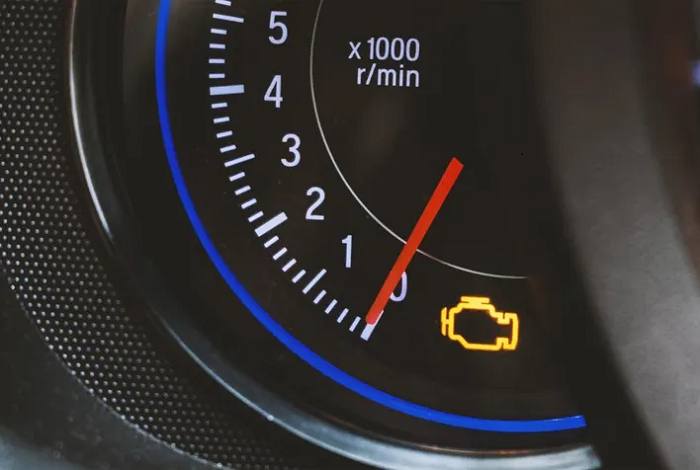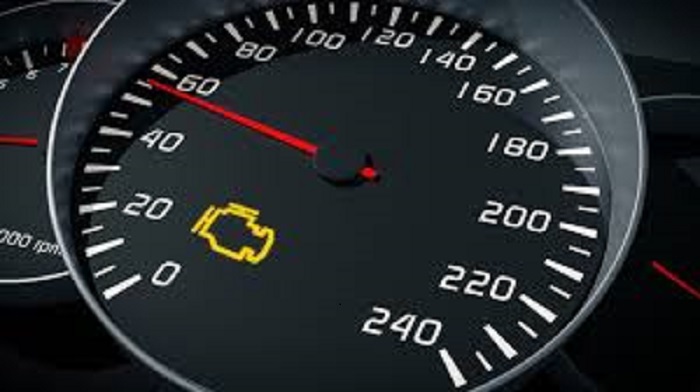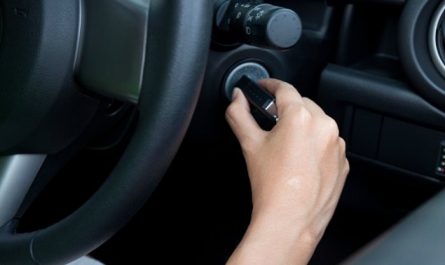What Does A Check Engine Light Mean?
An essential part of your car’s onboard diagnostic system is the check engine light (CEL), which is meant to warn you of possible problems with the engine or emissions systems. This light indicates—but does not identify—that the car’s diagnostic system has found an abnormality or malfunction when it turns on.
The check engine light (CEL) can appear in a variety of ways to indicate different degrees of urgency related to the state of your car. Knowing these signs aids in evaluating the problem’s seriousness and choosing the best course of action.
Solid Light
When the CEL shows up as a solid light, it usually indicates a non-critical problem that has to be fixed but is not life-threatening. This kind of lighting frequently denotes issues that are not as serious or have a minimal effect on the operation of the vehicle. Solid CELs are frequently caused by problems such as a malfunctioning or loose gas cap, which can impact the fuel vapor containment system, or small problems with the emissions control system. Even while there may not be an immediate risk to the vehicle’s operation, it is crucial to take care of the issue as soon as possible to avoid further damage or higher repair expenses. The solid CEL acts as a prompt to run a diagnostic to find and fix the underlying problem.
Flashing Light
A check engine light that flashes suggests a more serious issue that has to be fixed right away. This signal typically indicates serious problems that, if ignored, could cause serious engine damage or have an impact on the vehicle’s safety and performance. Engine misfires, which can be caused by malfunctioning spark plugs, ignition coils, or fuel injectors, are frequently the cause of a flashing CEL. Misfires can result in higher emissions, decreased engine efficiency, and possibly even long-term engine damage. As soon as it is safe to do so, you must stop driving and get professional assistance to diagnose and fix the problem when the CEL flashes. Ignoring a flashing CEL may make the issue worse and require more involved repairs.

Is Your Check Engine Light On? Here Are 10 Possible Reasons Why?
The check engine light (CEL) on your car indicates that there is a problem with the engine or emissions system that needs to be fixed. This light is an early warning system meant to notify you of many possible problems, even if it can be unsettling at times. Knowing the typical causes of a CEL will enable you to handle the issue successfully. The following 10 scenarios could be the cause of your check engine light being on:
Loose or Faulty Gas Cap:
A broken or loose gas cap is one of the most obvious causes of a CEL light. The integrity of the vehicle’s evaporative emissions system depends on the gas cap. Fuel vapors may escape if it is not sealed tightly, setting off the CEL. Usually, this may be fixed easily by just replacing or tightening the gas cap.
Oxygen Sensor Failure:
The oxygen sensor assists in controlling the air-fuel mixture for the best possible combustion by measuring the amount of oxygen in the exhaust gases. Inefficient engines, higher emissions, and poor fuel economy can all be caused by a malfunctioning oxygen sensor. Maintaining engine efficiency and adhering to emissions regulations require replacing a defective oxygen sensor.
Catalytic Converter Issues:
Before toxic gasses from the engine leave the exhaust system, the catalytic converter changes them into less damaging chemicals. Emissions, fuel economy, and engine performance can all be negatively impacted by a faulty catalytic converter. Due to the fact that it is an essential part of the emissions control system, this problem frequently calls for professional diagnosis and replacement.
Spark Plug or Ignition Coil Problems:
Ignition coils and spark plugs are necessary for healthy engine combustion. The engine’s cylinders’ air-fuel mixture is ignited by spark plugs, and the electrical spark required for this is produced by ignition coils. Reduced acceleration, rough idling, and engine misfires may result from either component failing. To avoid performance problems, it’s crucial to perform routine maintenance and prompt replacement of these components.
Mass Airflow Sensor Malfunction:
The air-fuel mixture can be adjusted with the aid of the mass airflow sensor (MAF), which gauges the quantity of air entering the engine. Reduced fuel efficiency, higher emissions, and subpar engine performance can all result from a defective MAF sensor. Engine performance and efficiency can be restored by cleaning or replacing the MAF sensor.
Engine Timing Issues:
Engine timing issues can lead to serious engine problems. These issues are typically caused by a worn-out or defective timing belt or chain. For synchronous movement of the valve and piston, timing is essential. If timing problems are not fixed, engines may misfire, run rough, or even sustain significant damage. To avoid such problems, routine inspections and prompt timing belt or chain replacement are crucial.
Faulty EGR Valve:
By returning a part of the exhaust gases to the engine’s intake manifold, the Exhaust Gas Recirculation (EGR) valve helps lower nitrogen oxide emissions. Increased emissions, harsh idling, and poor engine performance can all be caused by a malfunctioning EGR valve. EGR valve problems are usually resolved by cleaning or replacing the valve.
Vacuum Leak:
An unintentional gap or break in the intake manifold or vacuum lines causes a vacuum leak. This may result in an imbalance between the air and fuel mixture, which could cause the engine to stall, idle harshly, or perform less well. Maintaining engine performance and efficiency requires finding and fixing vacuum leaks.
Faulty Transmission Fluid Temperature Sensor:
The transmission fluid temperature sensor in contemporary cars keeps an eye on the fluid’s temperature to guarantee optimal performance. Problems with transmission performance, like slippage or unpredictable shifting, might be caused by a defective sensor. The defective sensor can be replaced to let the transmission operate properly again.
Issues with the EVAP System:
Fuel vapors are kept from escaping into the atmosphere by the Evaporative Emissions Control (EVAP) system. The CEL may be activated by issues with the EVAP system, such as a broken charcoal canister or a malfunctioning purge valve. It’s critical to solve EVAP system problems as soon as possible because they can have an impact on emissions and fuel economy.

What to Do About the Check Engine Light?
It’s critical to take quick action when your check engine light (CEL) comes on in order to protect your car from any harm and guarantee peak performance. Here’s what you do, step-by-step, when the CEL illuminates:
Check for Simple Issues:
Examine simple, readily fixed problems first. A malfunctioning or loose gas cap is a common source of the CEL. Make sure the gas cap is tightened all the way. The light can go out after a few driving cycles if it was loose. Also, look for any obvious difficulties that could give you hints about the underlying reason, including strange noises or performance concerns.
Observe Vehicle Behavior:
Keep a close eye on the performance of your car. Take note of any modifications in the engine’s performance, such harsh idling, sluggish acceleration, or stalling. Your next steps can be guided by these symptoms, which can also help you determine how serious the issue is. Usually, when the CEL flashes, there’s a more significant problem going on that needs to be addressed right away.
Consult the Owner’s Manual:
See the owner’s manual for your car for detailed information about the CEL. The handbook might offer further details on the type of warning light and offer some fundamental troubleshooting techniques. It might also provide direction as to whether the problem is urgent or best left for later.
Perform a Diagnostic Scan:
Use an OBD-II scanner to obtain the error codes from your car’s computer system in order to make an accurate diagnosis. These codes help identify the precise system or component that is impacted and offer comprehensive information about the issue. Free diagnostic scans are available at many auto parts retailers, or you can use your own personal scanner if you own one. These scanners are often used by skilled mechanics for thorough analysis.
Seek Professional Assistance:
See a qualified mechanic if the diagnostic scan identifies a complicated problem or if fixing little issues doesn’t stop the CEL from staying on. An expert technician is able to carry out the required repairs, decipher error codes, and carry out a comprehensive examination. They possess the knowledge and resources necessary to identify and resolve more significant problems that a simple diagnostic scan might miss.
Address the Issue Promptly:
As soon as the issue has been located, move quickly to fix it. Ignoring the CEL can result in greater damage and expensive repairs, particularly if it is flashing. Taking care of problems as soon as they appear keeps cars operating well and keeps small issues from getting worse.
Monitor the Light:
After making any adjustments or corrections, monitor the CEL. After resolving the issue, if the light goes out, it means the problem is fixed. To make sure that the underlying problem has been adequately addressed, additional research might be required if the CEL stays on or returns.
Brief History of the Check Engine Light
Since its introduction, the check engine light (CEL) has undergone a substantial evolution that reflects developments in automobile diagnostics and technology. Its advancement is directly linked to the changes in onboard diagnostic systems and car pollution regulations.
Early Days of Automotive Diagnostics:
Vehicle diagnostics were primarily manual and relied on mechanical gauges and visual inspections prior to the introduction of the check engine light. Simple technologies for keeping an eye on pollution and engine performance were absent from early autos. Symptoms such as strange noises or poor performance were frequently used to identify problems, and mechanics had to manually troubleshoot them.
Introduction of On-Board Diagnostics (OBD):
On-Board Diagnostics (OBD), which was first introduced in the 1980s, marked a significant milestone in the development of contemporary automotive diagnostics. The purpose of the OBD-I system is to track the effectiveness of the car’s emissions control system. It made it possible for mechanics to obtain error codes from the car’s computer, which identified particular issues with parts like oxygen sensors or the catalytic converter. OBD-I systems, however, had a narrow reach and were not manufacturer-standardized.
Standardization with OBD-II:
The major game-changer was the introduction of the On-Board Diagnostics II (OBD-II) system in 1996, which made it required for all cars sold in the US. OBD-II offered a standardized, all-inclusive diagnostic framework, which was a major improvement over its predecessor. It included a communication protocol and connector standard that allowed for more thorough and reliable car system monitoring.
The check engine light was incorporated into the OBD-II system’s diagnostic capabilities. The purpose of this light, also referred to as the Malfunction Indicator Light (MIL), is to notify drivers of problems that the onboard computer has identified. In contrast to older systems, OBD-II offered a wider variety of diagnostic data, including particular error codes that denoted issues with certain engine and emissions componentry.
Advancements and Modernization:
The OBD-II system and the check engine light have developed further over time. Modern cars are outfitted with sophisticated diagnostic equipment that offers more precise data regarding the condition of the vehicle. Beyond the engine and emissions controls, these systems may keep an eye on a lot of other parts as well, such fuel efficiency and gearbox performance.
More approachable diagnostic instruments have also been developed as a result of advancements in automotive technology. Modern cars come equipped with improved interfaces that make troubleshooting and error code interpretation simpler. Furthermore, several manufacturers enable drivers access to real-time data and alarms directly through applications and onboard displays.


